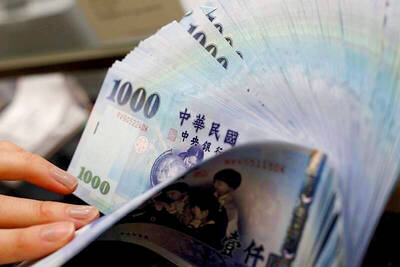US DRAM maker Micron Technology Inc is set to install the industry’s most cutting-edge technology — extreme ultraviolet (EUV) lithography equipment — in its facility in Taichung this year, the company said yesterday.
In early preparation for the volume production of 1-gamma nanometer node DRAM, “we plan to introduce EUV tools to our Taichung fab later this year,” Micron president and chief executive officer Sanjay Mehrotra said via video at the Computex trade show in Taipei.
Gamma refers to the dimension of half the distance between cells in a DRAM chip.

Photo courtesy of Micron Technology Inc via CNA
Micron is also looking forward to beginning mass production of its next-generation DRAM products manufactured using the 1-beta nanometer node process in Taiwan next year, Mehrotra said.
“These two installations are another milestone in our continued growth and commitment to Taiwan,” he said.
Micron last year unveiled its 1-alpha nanometer node DRAM, which the company said has 40 percent more memory density than its 1z nanometer node DRAM.
Micron’s Taiwan fabs have begun volume production of 1-alpha nanomerter node DRAM, starting with DDR4 memory for computer customers and consumer PC DRAM products for its Crucial brand, the company said in a news release in January last year.
The largest foreign employer and foreign direct investor in Taiwan with more than 10,000 employees in its fabs in Taichung and Taoyuan, Micron would continue to expand its recruitment of highly skilled personnel in the years ahead, it said.
Digitimes Asia yesterday reported that Micron has placed orders for EUV equipment and plans to transition to EUV technology to manufacture its 1-gamma nanometer node DRAM starting in 2024.

Merida Industry Co (美利達) has seen signs of recovery in the US and European markets this year, as customers are gradually depleting their inventories, the bicycle maker told shareholders yesterday. Given robust growth in new orders at its Taiwanese factory, coupled with its subsidiaries’ improving performance, Merida said it remains confident about the bicycle market’s prospects and expects steady growth in its core business this year. CAUTION ON CHINA However, the company must handle the Chinese market with great caution, as sales of road bikes there have declined significantly, affecting its revenue and profitability, Merida said in a statement, adding that it would

MARKET LEADERSHIP: Investors are flocking to Nvidia, drawn by the company’s long-term fundamntals, dominant position in the AI sector, and pricing and margin power Two years after Nvidia Corp made history by becoming the first chipmaker to achieve a US$1 trillion market capitalization, an even more remarkable milestone is within its grasp: becoming the first company to reach US$4 trillion. After the emergence of China’s DeepSeek (深度求索) sent the stock plunging earlier this year and stoked concerns that outlays on artificial intelligence (AI) infrastructure were set to slow, Nvidia shares have rallied back to a record. The company’s biggest customers remain full steam ahead on spending, much of which is flowing to its computing systems. Microsoft Corp, Meta Platforms Inc, Amazon.com Inc and Alphabet Inc are

RISING: Strong exports, and life insurance companies’ efforts to manage currency risks indicates the NT dollar would eventually pass the 29 level, an expert said The New Taiwan dollar yesterday rallied to its strongest in three years amid inflows to the nation’s stock market and broad-based weakness in the US dollar. Exporter sales of the US currency and a repatriation of funds from local asset managers also played a role, said two traders, who asked not to be identified as they were not authorized to speak publicly. State-owned banks were seen buying the greenback yesterday, but only at a moderate scale, the traders said. The local currency gained 0.77 percent, outperforming almost all of its Asian peers, to close at NT$29.165 per US dollar in Taipei trading yesterday. The

The US overtaking China as Taiwan’s top export destination could boost industrial development and wage growth, given the US is a high-income economy, an economist said yesterday. However, Taiwan still needs to diversify its export markets due to the unpredictability of US President Donald Trump’s administration, said Chiou Jiunn-rong (邱俊榮), an economics professor at National Central University. Taiwan’s exports soared to a record US$51.74 billion last month, driven by strong demand for artificial intelligence (AI) products and continued orders, with information and communication technology (ICT) and audio/video products leading all sectors. The US reclaimed its position as Taiwan’s top export market, accounting for